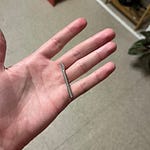If I’m going to be exploring what I’m calling the “kink as therapy” discourse, I suppose I must define my terms.
What is therapy? For our purposes, “therapy” is an umbrella term encompassing psychotherapy and counseling, which employ various psychological methods and modalities to help someone change their behavior and overcome personal problems in order to improve well-being and mental health.
What is kink? I have written a lot on this topic and yet I still find it difficult to define it succinctly, so here goes nothing: Kink and BDSM and leather are proximate, if not interchangeable, terms for sexual subcultures and practices* based in power exchange and sensation exploration. The acronym “BDSM” is an intricate one, standing for, alternately and simultaneously: “bondage and discipline,” “Dominance and submission,” and “sadism and masochism.”
Now, I’m defining our terms because I want to make something coherent for you here, and also because these terms in particular are already so nebulously defined. I’m reminded of the night that BAD GAY and I discovered Shawn Mendes (sorry, we’re in our thirties). We stayed up late watching all of his music videos, swooning over his resemblance to a Sean Cody model, catching up on his relationship with the benighted and bearded Camila Cabello, and immersing ourselves in his just top-notch cultural contributions, including his definition of therapy, which I’ve taken from his Wikipedia page.
“Therapy is what works for you: climbing a mountain, listening to music and running on the treadmill, going to dinner with your friends. It's something that distracts you, that helps you heal, and so it just depends on what you think therapy is.”—Shawn Mendes
This really was my shot heard round the world. Mendes’ idea of therapy has been stripped of meaning, flayed so close to the bone that even euphemism can’t cling like so much gristle. He might be an outstanding specimen, but in this instance Mendes is par for the course in a culture where commodification has rendered language around mental health almost entirely meaningless. The conflation he employs here—Therapy is whatever makes you feel good—is reminiscent of a parallel kind that I griped about in my recent series on kink and validity, where I pointed out that while labels can be constraining and counter-productive to the liberatory project of self-determination, being unable to identify and define concepts such as therapy, kink, and oppression tends to reinforce structural powers that they’re meant to disrupt, or at least question.
Not long ago, I tweeted, “what is kink, really? is it a gentle breeze? is it a kiss under the mistletoe?” I was joking about the kink Overton Window (otherwise known as the window of discourse). If kink can be anything, it’s all the more easy to commodify what is, or what should be, or what once was a radical subculture for mainstream, whitewashed, pro-carceral, pro-capitalist palates. The problem with broadening (i.e., diluting) radical or subversive thoughts and concepts is that it allows us to rehabilitate them, to make them safe—not safe for us, as marginal people, but safe for corporations to make a profit.
When I began this series, I had the intention of being sort of assy and bitchy about people who claim that kink can be therapy (not therapeutic, but therapy, as in, a replacement or stand-in for the medical** relationship between a licensed professional and a patient). My sense of this ambient conflation, which I’ve observed on social media and in real life, particularly among self-styled kink and BDSM educators and influencers, was that people whose conception of kink as an arm of therapy betrayed a shallow understanding of both concepts.
But I’m beginning to think that, as fun as it is to be a hater, my initial approach was shallow, too, and that what’s really going on here is that any conflation, confusion, merging, or blending of meaning is not just a misunderstanding of kink and therapy, but a cynical commodification of both through respectability politics.
Does this mean I’m above hating on individuals? Absolutely not. Listening to an interview with a queer 24/7 submissive BDSM educator about the therapeutic properties of kink that managed to be both homophobic and anti-leather as prep for this piece has made absolutely certain of that. But more on that next time, when I’ll be digging into the limitations of not only this “kink as therapy” viewpoint, but of therapy, in its spectrum of commodification, overall. Until then.
David tweets at @k8bushofficial. Read Part 1 and Part 3.
*I don’t know that I think BDSM is inherently sexual, and taking a definitive stance on that might be impossible. But it’s fair to say that BDSM is inextricably tied to sexualized people. Kink, regardless of who is practicing it or in what way, is always going to be sexualized because its practitioners—or the ones who are punished for it, anyway—always are, in the same way that everything we homos do is always essentially and inherently sexual. Like how it’s controversial for drag queens to read books to schoolchildren.
**This is not an unproblematic relationship or practice. I will be getting into all that in our next post.












